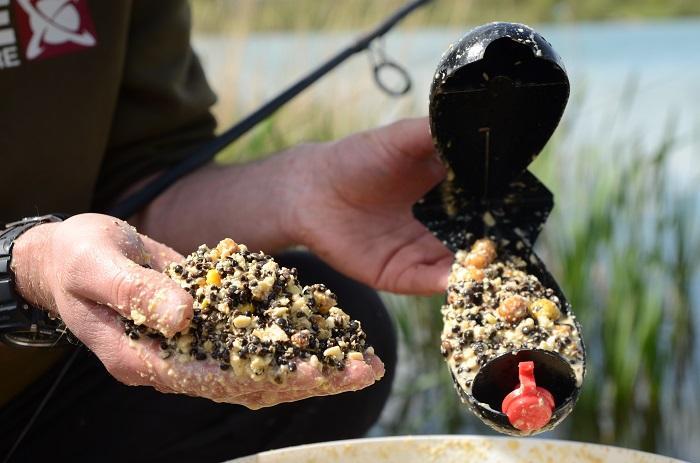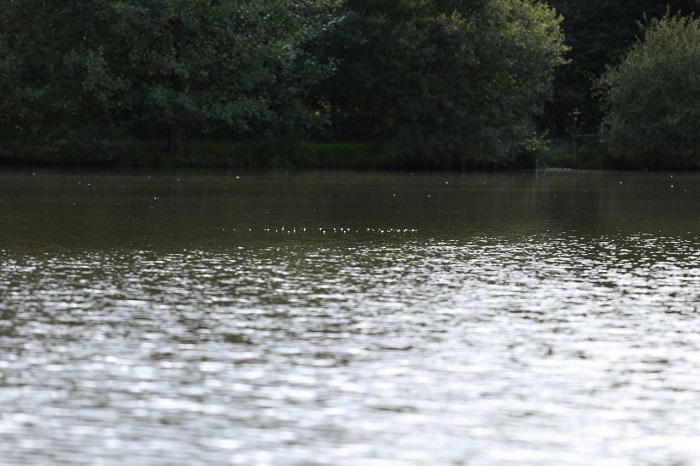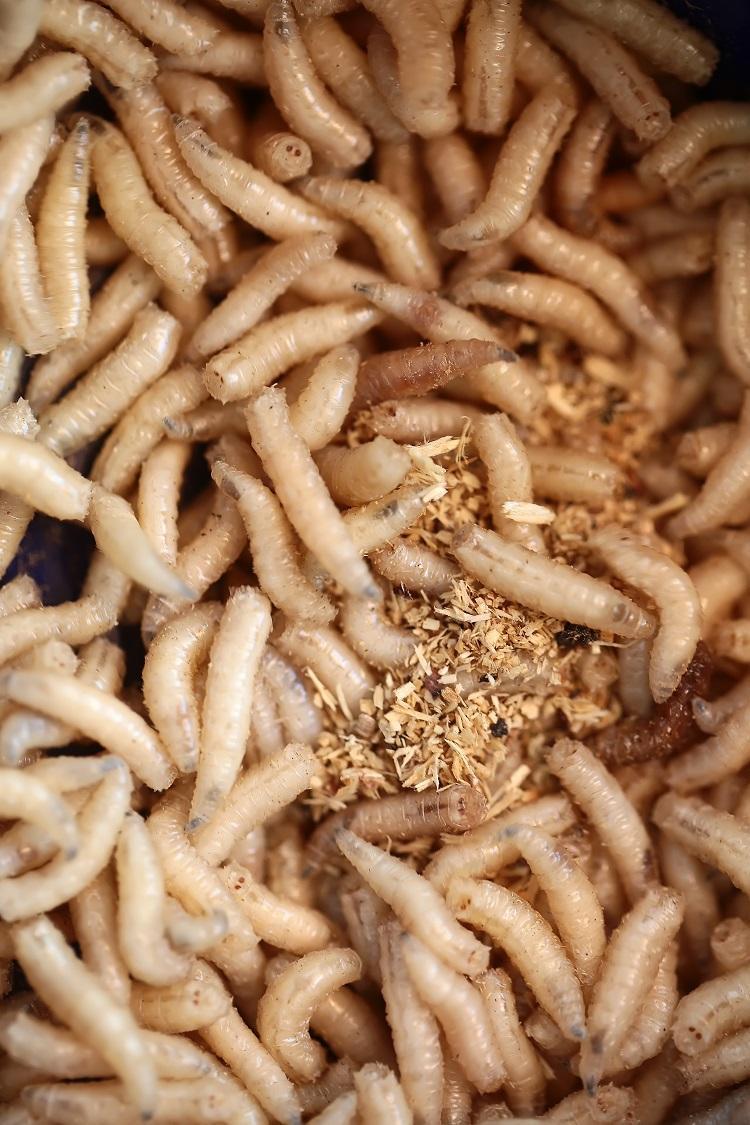In a sport awash with variables and choice, it’s perhaps the use of bait that gives most anglers cause to stop and think. As your hand wavers over your throwing stick or dithers next to your catapult the fundamental question remains – am I putting out too much, or too little?
Carp, of course, can’t tell us the answer directly, but you can build up a feel for what is ‘just right’ on any given session using a mix of experience and trial and error. This is simpler on well-stocked venues where a rise or fall in the number of expected bites is easier to detect and put into patterns, but the carp’s behaviour on trickier waters can also tell you when you’re getting it wrong or right.

Too much bait or too little
Before anything else you need to be familiar with the perils of baiting too heavily or too lightly. Not enough bait can lessen the attraction of your spots and fail to alert carp to the feast on offer. It can also fail to hold carp that do get their heads down on your areas. This means grazing, nomadic shoals could finish off your freebies and drift off to another area before you’ve maximised your chances of getting the most from the feeding spell.
If you introduce too much, statistically speaking you lessen the chances of a fish picking up your hookbait, but you might also create an area that looks too much like a blatant trap, thus spooking the fish. On some waters you also run the risk of attracting nuisance species. In extreme cases, uneaten bait left for weeks on the lakebed can rot and produce water-quality problems and create no-go zones for the fish.

What is the right amount of bait?
So, what can you do to fall in the sweet spot between too little and too much? Firstly, you can listen to one of the few cliches in angling which actually makes perfect sense – you can put more bait in, but you can’t take any out. What does this glib (but useful) saying mean in practice? It reminds you that taking a gentle, little-by-little approach to baiting is advisable unless you’re absolutely sure of the carp’s appetite.
A standard approach that works so well for day-ticket masters like Tom Maker is to begin your session by introducing some bait – say, six to 10 Spombs – then be guided by what happens next. If you start getting bites from carp, tench or bream, the chances are that at least a few fish are on the spot and feeding, so you’ll need to replenish the area. If action isn’t forthcoming, you won’t want to add too much extra bait, but one or two Spombs, or a few catapult pouches, full of bait can trigger a feeding response thanks to the sound and attraction of fresh loosefeed entering the water. If you start getting multiple takes, then you can obviously increase how much you’re putting in, but pay close attention to any patterns that form. Note down whether introducing some more bait can kickstart your swim, or whether it actually delays bites, and work out when the likely bite time is.
The exact same approach can be applied to whether you are fishing a day ticket lake in the UK where you don’t know how much bait is already in the swim, or on a holiday lake in France where you do know how much bait the previous weeks anglers have applied.

Use a quality bait
Using high-quality boilies, such as those offered by DNA Baits, is crucial for several reasons —primarily among them being fish health. Premium bait provides a balanced blend of ingredients designed to supply carp with the essential nutrients they need for healthy growth and long-term wellbeing.
The second reason is directly tied to the first: better bait leads to better results. Simply put, using top-tier boilies typically results in catching more fish.
Carp are naturally inquisitive and will sample a variety of items from the lake bed in their search for food. This explains why artificial hook baits, like imitation corn or plastic maggots, can sometimes be effective. However, while carp are curious, they’re also highly sensitive. Low-quality bait lacks the appeal and staying power needed to consistently attract them. Inferior options are often dismissed as non-viable food sources.
One major difference lies in the composition. Quality boilies are usually made with nutrient-rich animal and insect meals, which are high in amino acids—key compounds that emit powerful feeding signals in the water. In contrast, cheaper boilies tend to rely on plant-based flours, which lack the same nutritional profile and attraction.
Additionally, many premium boilies are infused with natural liquids during the production process. These may include marine extracts, liver-based solutions, or bloodworm infusions. Being water-soluble, these liquids significantly boost the bait’s dispersal properties, making it easier for carp to detect. Top-tier formulations also feature potent attractants and appetite enhancers such as betaine, yeast extracts, aminol, and pre-digested fish meals—ingredients that further elevate their effectiveness.
Knowing when the feeding windows are
Whether you’re fishing a well-stocked runs water or a rock-hard gravel pit, knowing when bite time is can be vital. It’s obviously easier to work this out on the former type of venue, but a bit of research can help put you on the right track at the latter. Once you know when the optimum time for bites is, you can really use this to plan your baiting approach. Received wisdom suggests you should bait up ahead of bite time, not during it. This creates minimal disturbance when you believe fish will be feeding in your area, but of course you can replenish the spot if you start to get takes. It’s probably advisable not to keep on piling bait in as you get towards the end of the predicted feeding window and it may well depend on what type of baiting you’re using, and the presence of other species, as to how far in advance you feed your spot.

Bait application mechanics
Another couple of things to consider are the actual mechanics of bait introduction. For instance, if it’s a windy day or your lake is deep and prone to undertow, bear in mind that lighter baits can drift quite significantly away from your spot once they hit the water. On calm days or in shallow water, you can bait up with items like hemp and maggots with confidence that they’ll flutter down fairly close to the spot on which they landed, but if a wind whips up then you might want to consider baiting with boilies, nuts and other heavier items for maximum accuracy beneath the surface.

How does your bait look on the lake bed
It is also worth familiarising yourself with what exactly ‘a lot of bait’ really looks like underwater. Your perception, as you empty half a bucket of mixed freebies into a few consecutive Spombs, might be that you’re really piling it in, but – as many sub-surface films have demonstrated – anglers largely overestimate how well covered in bait their spots are.
Pre-baiting can give you a huge edge
Finally, don’t be confined to thinking of baiting up as a job you only do when you’re fishing. Pre-baiting, even with small amounts, can be the best way to train fish to associate certain areas and times of day with a free meal. As any matchman will tell you, ‘little and often’ is a great baiting mantra, and it certainly extends to pre-baiting days and weeks in advance of a session. Picking a spot you can view from the bank, or up a tree, is ideal for your first pre-baiting mission on a new venue as you can assess how much has been eaten each time you visit the water.
In short, let the fish’s behaviour guide your baiting approach and always look for patterns that can be applied from water to water.
